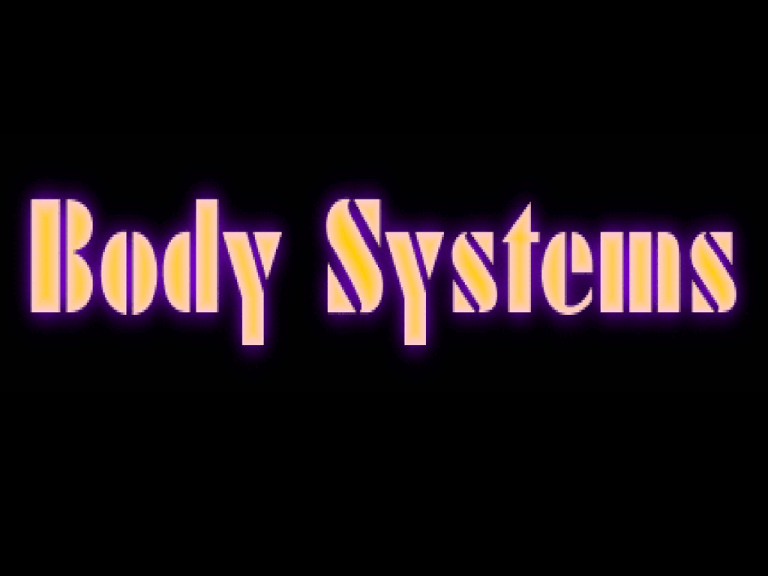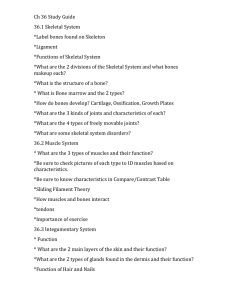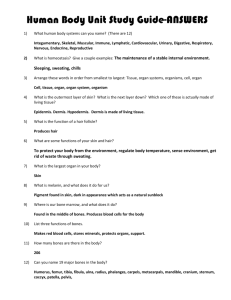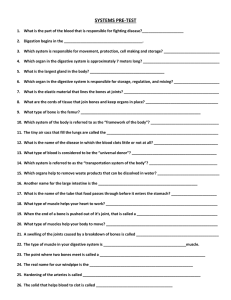Document
advertisement

• Cell • Tissue • Organ • Body System Your body is made up of billions of cells ( basic unit of living things) Groups of cells working together are tissues A group of tissues working together are organs Organs all have specific jobs (heart is to pump blood, but can the heart get blood to all other body parts by itself?) A group of organs working together to complete a task is a body system Body systems play different roles in the body, but work together to maintain homeostasis Homeostasis is the condition in which the body’s internal conditions are at a stable state Example: Needing more oxygen during exercise. Which two systems work together to provide it? Example: Running. Which two systems work together to provide it? • Perform a skit where characters are different organs. Discuss and demonstrate in your skit what happens as a person begins to exercise. All of the body systems are IMPORTANT If one does not work properly, then it affects the others Body systems are dependent on each other, so it is important to take care/ protect each system • • • • • • • Bone Bone Marrow Joint Skeletal System Cartilage Ligaments Tendons • Skeletal system is an internal system made up of bones, joints, and connective tissue A bone is an organ in the skeletal system There are 206 bones in the body Functions of bones: o Bones are hard because they store minerals- Calcium and phosphorus, for use when the body needs it- mineral that maker bones strong and healthy o They protect soft organs- Provide framework around internal organs o Support the body- Vertebrae has 24 bones, supporting head, neck, and protect spinal cord o Allow movement- muscles pull on bones to move o Form new blood cells- Inside the bones are bone marrow (soft tissue) that makes blood cells for the body Joints are a place where two or more bones meet Bones are held together at joints by tissues called ligaments- help hold bones in place Joints allow the body to move in controlled ways Tissues called tendons attach muscle to bones – Achilles tendon When muscles move, they cause bones to move too Hinge joints -One direction movement only Gliding joints - Enable bones to slide over one another Pivot joint- Moves side to side, up and down, but for limited rotation Ball and socket joint - Move in all directions, allowing rotation Ligaments- connect bones to joints Tendons- attach muscle to bones Cartilage- strong, flexible tissue that provides cushioning at your joints Fractures- break in a bone Dislocations- bone pushed out of joint Sprains- stretching or twisting a ligament Osteoarthritis- breakdown of cartilage, causing stiffness and swelling Scoliosis- sideways curvature in spine Osteoporosis- condition of brittle and porous bones (long term deficiencies in calcium, Vitamin D and lack of exercise) Be physically active- walking and jogging increase bone mass Eat foods high in calcium and phosphorus- Dairy products, liver, beans, and whole grains Sit, stand, and walk in straight posture- keeps spine healthy and protects spinal cord Pay attention to your shoes- Should have correct arch support and should be able to wiggle toes, this provides support of bones in your feet • List three parts of the skeletal system and give a brief description of each. • Group of structures that make your body parts move • Most important muscle: the heart • Anyone ever worn a cast? How did your muscles feel when you got your cast off? Anyone started working out? How did your muscles feel when you started working out? DRAW a conclusion about muscle strength. Cardiac- muscle that forms the heart Smooth- forms some internal organs Skeletal- muscle attached to bones When muscles contract they pull two ends toward center If the two ends are attached to bones, they are pulled too Most body movements require effort from two muscles or muscle groups • Work in pairs to select a specific muscle that might cramp and what are good stretches to relive that cramp. • Perform stretches on page 374 in book A pulled or torn muscle- torn away from bone or damaged Muscle strain- soreness developed by overuse Cramped muscle- remains contracted instead of extending Muscular dystrophy-disorder inherited, causing gradual weakening Engage in regular physical activity Warm up before physical activity Eat foods containing carbohydrates and protein Maintain a healthy weight Learn to lift properly • Heart, blood vessels, stomach, intestines, and toes. Identify the type of muscle tissue that is associated with each one. Heart, blood Vessels, stomach, intestines, toes. Digestion is the changing of food you can eat into substances the body can use Digestive system- is an organ system that converts food to a form useful for the body Digestion frees nutrients so they can be used by the body Nutrients are substances that the body needs to work properly Cells use nutrients to grow, repair themselves, and get energy Digestion begins in the mouth Teeth cut and grind food while saliva moistens it Saliva ( fluid produced by salivary glands) is 99% water Passes through pharynx and esophagus It enters the stomach- collected and churned like a food processor Goes to small intestine- coiled 20 foot long tube, where it absorbs most nutrients, which are used by the body for growth, energy, and repair. Digestion is completed here Food then enters large intestine and then excreted through the anus Liver- a large gland where many digestive functions occur. Produces bile to get rid of fats Gallbladder- small saclike organ that stores bile Pancreas- organ that produces enzymes that assist in digestion. Releases enzymes directly into the small intestine Kidneys- Blood carries waste to kidneys, who mix it with water and excrete it as urine Sweat glands remove salt and water from body Lungs remove carbon dioxide from body • • • • Find the surface area of clay. Cut the clay into 4 smaller pieces. Measure the surface area of each of the cubes. Compare the surface area of the smaller pieces to the big piece. • A system that removes waste from the body Excretion is the process of removing wastes from the body Remains that cannot digest pass to the colon- large intestine The lining of the colon absorbs most liquid forms of undigested material The solids are deposited as feces When the colon is full it sends a message to the brain to contract and push out the feces from the anus • The small intestine is 20 ft long and spends about 4 hours there. • How many feet does it travel an hour? • The large intestine is about 5 feet long. Food spends about 10-15 hours there. • What speed does food move through the large intestine? • How much faster does food travel through the small intestine that through the large intestine? • Why is it important to drink plenty of water? Indigestion- uncomfortable feeling in stomach from eating to quickly or too much Diarrhea- watery feces-may be caused by bacteria in food Ulcers- sores on interior stomach or small intestine Cirrhosis-destruction of liver Gallstones- mineral crystals on gallbladder, block passage of bile Kidney stones-like gallstones but block passage of urine Appendicitis- inflammation of appendix Hemorrhoids-swelling of veins at the opening of the anus Colon cancer –growth of abnormal cells in the colon Eat a variety of foods- low-fat and high-fiber foods Eat complete meals- eating breakfast is extremely important Do not rush meals Chew food thoroughly- do not wash big pieces down with a drink Drink plenty of water- 6 to 8 glasses a day of 8 ounces of water See your dentist regularly • What have you learned about the Digestive and Excretory systems? • Organs and tissues that transport essential materials to the body cells and remove their waste products Made up of plasma, platelets, white blood cells, and red blood cells Plasma is liquid where the body cells absorb water Platelets help form clots where there is injury in a blood vessel White blood cells fight off infection Red blood cells carry oxygen throughout the body Blood moves through blood vessels Blood vessels that carry blood away from the heart are arteries Blood vessels that carry blood to the heart are veins Capillaries carry blood between veins and arteries Pulmonary circulation- flow of blood from the heart to the lungs and back to the heart Systematic circulation- flow of blood to all the body tissues except the lungs Contracts and pumps blood through blood vessels Heart (with 4 chambers) Right ventricle pumps blood to lungs, where it exchanges carbon dioxide for oxygen Blood flows into the left atrium It pumps blood to the left ventricle The left ventricle pumps to the entire body The body absorbs oxygen and releases carbon dioxide Then it flows to the right atrium Right atrium pumps it to the right ventricle • Squeeze a tennis ball 70 times in a minute. This is the same force that heart needs to pump blood, and it does it 70 times a minute. • Act out the path of blood through the body. I need seven volunteers ( right atrium, left atrium, right ventricle, left ventricle, lungs, body part, and blood). Students sitting down need to tell me when oxygen is being gained or lost. • Act out the path of blood through the body. I need seven volunteers. Students sitting down need to tell me when oxygen is being gained or lost. Hypertension- blood pressure is consistently higher than normal Stroke- results from blood clots that block vessels to brain or rupture of one Heart Attack- blockage of the flow of blood to the heart Arteriosclerosis- arteries harden, reducing the amount of blood that can flow through them Anemia- abnormally low level of hemoglobin, protein that binds to oxygen in red blood cells Leukemia- disease where extra white blood cells are produced Hemophilia- disease where plasma does not contain substances to block or clot Limit fat in your foods- can deposit on artery walls, narrowing them and increasing blood pressure Get regular physical activity- strengthens heart muscles, allowing it to pump more blood with each beat Avoid tobacco- tobacco contains nicotine, which narrows arteries, requiring higher blood pressure Manage stress- under stress the body secretes adrenaline, which increases blood pressure • A. Provide each student or group of students with a cup of flour, one-fourth cup of salt, and one-half cup of hot tap water. Stir these ingredients together with a spoon until a ball forms. Check for desired consistency. If dough is too sticky, add more flour. If dough is too dry and more hot tap water. • B. With this ball of salt dough, the student(s) mold a human heart shaped model. Complete with aorta, superior vena cava, and inferior vena cava. Models will require several hours to dry. • C. After the model dries, the student(s) labels the four chambers: right and left atria, and right and left ventricles, and the major veins and artery. • D. Have the students to explain their models. • Draw the path of blood through the four chambers, lungs, and body. Supply oxygen to blood Remove carbon dioxide from the blood and release it outside the body Air enters through the mouth and nose Travels to pharynx Moves from the throat to the larynx or voice box Then to the trachea- a pipe that carries air deep into the body Then it splits into two branches at the bronchi Carries to the lungs- sponge-like organ that allows gases to pass between blood and air Your diaphragm separates the lungs from the abdomen The air you exhale contains more carbon dioxide and less oxygen than what you inhale Air is exchanged at the alveoli, microscopic air sacs in the lungs, to oxygen Moving air in and out of the lungs- breathing Air entering the lungs is inhalation Air leaving the lungs is exhalation Inhalation occurs when the diaphragm contracts and rib cage expands Influenza- colds caused by viruses Bronchitis- swelling of the bronchi due to infection Allergies- immune responses to foreign substances Asthma-inflammatory disease causing the bronchi to become narrowed or blocked Pneumonia- lung infection caused by viruses or bacteria Emphysema- disease where alveoli becomes damaged or destroyed Tuberculosis-bacterial lung infection Lung Cancer- disease where lung tissue are destroyed by the growth of a tumor Stay active Avoid smoking and second hand smoke Avoid polluted air Reduce your risk of respiratory infection- wash hands regularly with soap and water and avoid touching your nose and mouth • Explain the breathing process. Specialized cells make up nervous system are neurons Neurons carry information Controls all body activities Two types of neurons: sensory- send message to spinal cord and motor- receive messages from the brain and stimulate muscles to respond Major organ is the brain Movement, memory, learning, speaking, and the five senses are controlled by the brain Brain is attached to the spinal cord-carries messages to and from the brain Messages travel through nerves- bundles of cells that conduct messages from one part of the body to another There are two main parts of the Nervous Systems: o Central Nervous System (CNS)- brain and spinal cord Controls voluntary (walking) and involuntary (heart beating) actions o Peripheral Nervous System (PNS)- nerves that connect the CNS to all parts of the body Somatic system (actions controlled) and autonomic actions( actions don’t control) breathing Head injury- caused by a blow to the head or violent jarring of the head Spinal cord injury- can result from damage of head, neck, or spine Nerve inflammation- follow a minor injury Get enough sleep Avoid alcohol and other drugs Play safely Wear a seat belt Obey all traffic rules • What are the parts of the Nervous System and their functions? A chemical communication system that regulates many body functions A gland is a group of cells, or an organ that secretes a chemical substance They are secreted into the bloodstream Endocrine glands take signals from the brain or other glands The brain receives chemical and electrical messages from the body to the presence of substances in the blood The pituitary gland signals other glands to produce hormones when needed When you stress your palms get sweaty and heart beats fast Your adrenal glands respond by releasing adrenalinewhich prepares your body to respond to stress Heart rate and blood flow increase Blood sugar levels and blood pressure rises Air passages expand and sweat production increases Other body parts slow to conserve energy ( digestive system) When the stressful stimulus withdraws, the body returns to normal state Diabetes mellitus- caused by inadequate insulin production Overactive thyroid- swelling in neck Underactive thyroid- dull facial expressions Growth extremes- abnormal amounts of growth hormones Eat balanced meals Get enough sleep- period of reduced awareness where body slows down Engage in regular physical activity Keep things in perspective Have regular medical check-ups • “keeping things in perspective” Why is this hard for teens? How can you help someone from getting upset about minor issues? How can adults help? • Name a gland of the endocrine system and tell its function. Male reproductive cells are called sperm Males produce sperm at puberty- age 12-15 Sperm is produced in testes and mature in the epididymis Travel through vas deferens where they are mixed with seminal fluid The mixture is called semen Muscular contractions force semen though the urethra and out the body called ejaculation Sterility- inability to produce healthy sperm to reproduce Enlarged prostate gland- associated with aging Sexually transmitted Diseases- infections spread during sexual contact Cancer- uncontrolled cell growth that destroys healthy tissue Practice of self-examination- check for lumps Bathe regularly- ensure cleanliness Avoid wearing tight underwear- wear protective cup Practice Abstinence- until married The Menstrual Cycle As a female reaches puberty, hormones cause eggs to mature in the ovary Ovulation is the release of one mature egg each month The uterus thickens in preparation to receive and begin to nourish a fertilized egg If fertilization does not occur, then the lining is broken down and expelled The flow of the lining out of the body is menstruation Most females begin menstruation between 9-16 The times of ovulation may vary and degree of cramps and fatigue may vary, NO CONCERN • Premenstrual Cycle- physical and emotional changes before and during menstruation • Toxic Shock Syndrome- bacterial infection associated with incorrect use of tampons • Infertility-inability to reproduce • Ovarian cysts- growths on the ovary • Sexually Transmitted Diseases- diseases spread through sexual contact • Cancer-uncontrolled cell growth Examine your breasts- check for lumps Bathe regularly- change tampons and pads frequently too Record your menstrual cycles Practice abstinence- until married • Tell me what you have learned about your reproductive system.




